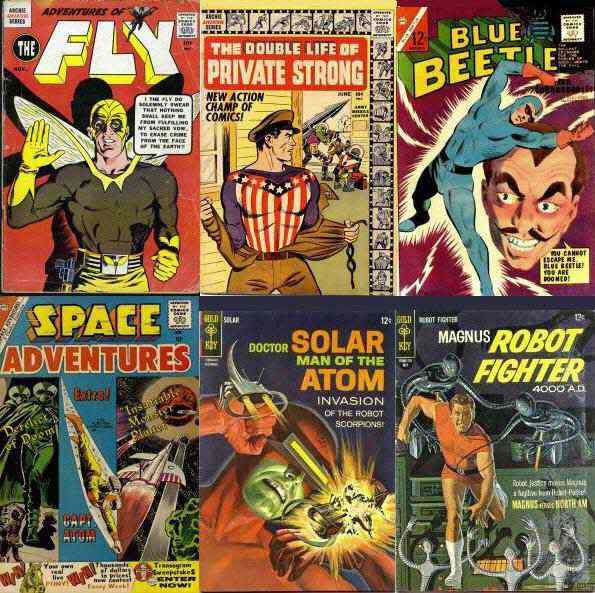
"In the 1940s the Big Companies-- with real offices, carpeted lobbies, pretty receptionists, "respectable" product, parental advisory committees, Hollywood licensing deals and deep-pocketed owners-- were National/DC, Fawcett and Dell/Western. Below those three snow-capped peaks stretched a bloody battleground of independents, hustlers, speculators, trend-watchers, pretenders, fly-by-nighters, check-bouncers, soft-porn peddlers, and moonlighting pulp publishers." Per Joe Simon, Leon Harvey pronounced that superheroes were still dead in early 1959. His Harvey Comics were all about kid-friendly fare like Casper the Friendly Ghost, while the former MLJ was now Archie Andrews' world. Fawcett was mostly out of the business, Charlton was geared toward keeping their presses running with low rent comics, Gilberton found their niche with Classics Illustrated and Martin Goodman's various lines were just another of the bunch of poor quality "mystery" comics still eked out under Code restriction against "horror."
After DC found some success with their super-hero revivals, these other publishers took note. While Archie was doing gangbuster business, they dipped their toes into the coming trend with Simon and Kirby's The Adventures of the Fly and Simon's The Double Life of Private Strong, both begun in 1959. According to author Gerard Jones, "Then National's lawyers got a look at Private Strong and sent a letter claiming that the Shield too closely duplicated Superman's powers. The series was instantly cancelled..." Meanwhile, Archie Comics managing editor Richard Goldwater didn't like Jack Kirby's art on the Fly, wanting that slick look the DC books had. "The new Fly crew-- John Giunta and John Rosenberger, a couple of DC backbenchers-- did indeed have DC's Frigidaire gloss, but their work was as dead as an empty refrigerator, and the hero buzzed along listlessly only until 1964." It was trailed by the "equally dull" The Jaguar, dead inside two years.
Charlton Comics took a stab in 1960 with the Captain Atom feature in Space Adventures. The title was usually "devoted to dark and apocalyptic SF in the pre-Schwartz mold," and mostly distinguished by the art of Steve Ditko, an unrecognized talent light years removed from the DC/Archie style. While the Captain Atom premise had promise, "in practice it rarely transcended red-baiting jingoism... reviving the aesthetic of the failed super-hero comebacks of 1953, when everything stank of McCarthyism. Captain Atom lasted only nine issues, by which time Ditko was able to make a living almost entirely from the Goodman company." Charlton tried again in 1964 with a Blue Beetle revival, whom they had bought cheap from Victor Fox. It ran a year and a half under Joe Gill, Bill Faccio, and Tony Tallarico.
"Western was an anomaly in the business, a respectable children's press," wrote Jones. "Through Dell it was hooked in the American News Company, making it the only comic book publisher with access to the erstwhile monopoly's high-profile newsstands." They held all the big licenses, like Disney, and were said to cancel any title selling under 600,000. "The the '50s it was the giant of all comics publishers, at times reportedly outselling all of its competitors combined... This was an old-line 'class' company. Remarkably few Jewish and Italian names appear in Western's credits in the early days, quite a contrast to the competition." The closest they came to superheroes were Turok: Son of Stone, The Phantom, Tarzan, and Korak: Son of Tarzan. That is, until they leapfrogged from a dime standard price to 15¢, 3¢ more than other publishers. Dell's bottom fell out, and there was a schism with Western, which began its own Gold Key imprint. National took the front in the aftermath, and their continued success with titles like Justice League of America inspired Gold Key to create Dr. Solar, Man of the Atom in 1962 and Magnus, Robot Fighter in '63. Lesser lights included Space Family Robinson, Mighty Samson, and Total War/M.A.R.S. Patrol, all in the mid- '60s. "Western's adventure line was ever thus: finely wrought, never electrifying."
Gerard Jones continued by noting, "For all their efforts at modernity, what's astonishing in these comics is their profound conservatism." Black and white morality, celebration of bourgeois self-sufficiency, preindustrial values and so on. "Magnus was at once a man-versus-machine tale with nineteenth-century echoes, a work-ethic warning of the dangers of indolence, and a flashback to the aristocratic terrors of losing control of the workforce-- not excluding the white terror of a slave insurrection from the antebellum South. One can read Magnus himself as the ultimate overseer, raised by a slaveowner's fantasy of the loyal slave to battle renegades and abolitionists. This was not, of course, the intention of the creators, but Western's traditional aesthetic adventure aesthetic carried with it old cultural shadows... well-intentioned and well-composed, but impossibly out of step with the youth culture of the 1960s."
American Comics Group stuck with "mystery" monster fare, aside from Nemesis, Magicman, and Herbie Popnecker's excursions as the Fat Fury. Harvey Comics stuck to its guns, only offering reprints of The Black Cat, while Jim Warren circumvented the Comics Code with his black and white horror magazines Creepy and Eerie (as well as Blazing Combat.)
Amongst all these throwbacks and parodies were few challenges to National's ascendancy, at least until Stan Lee decided to make his own run at Martin Goodman's company...
"The Other Guys" was chapter 6 of the 1997 edition of The Comic Book Heroes, and was not present in Gerard Jones' earlier collaboration with Will Jacobs. You can buy the 1997 edition of The Comic Book Heroes: The First History of Modern Comic Books - From the Silver Age to the Present from Amazon.com.


No comments:
Post a Comment